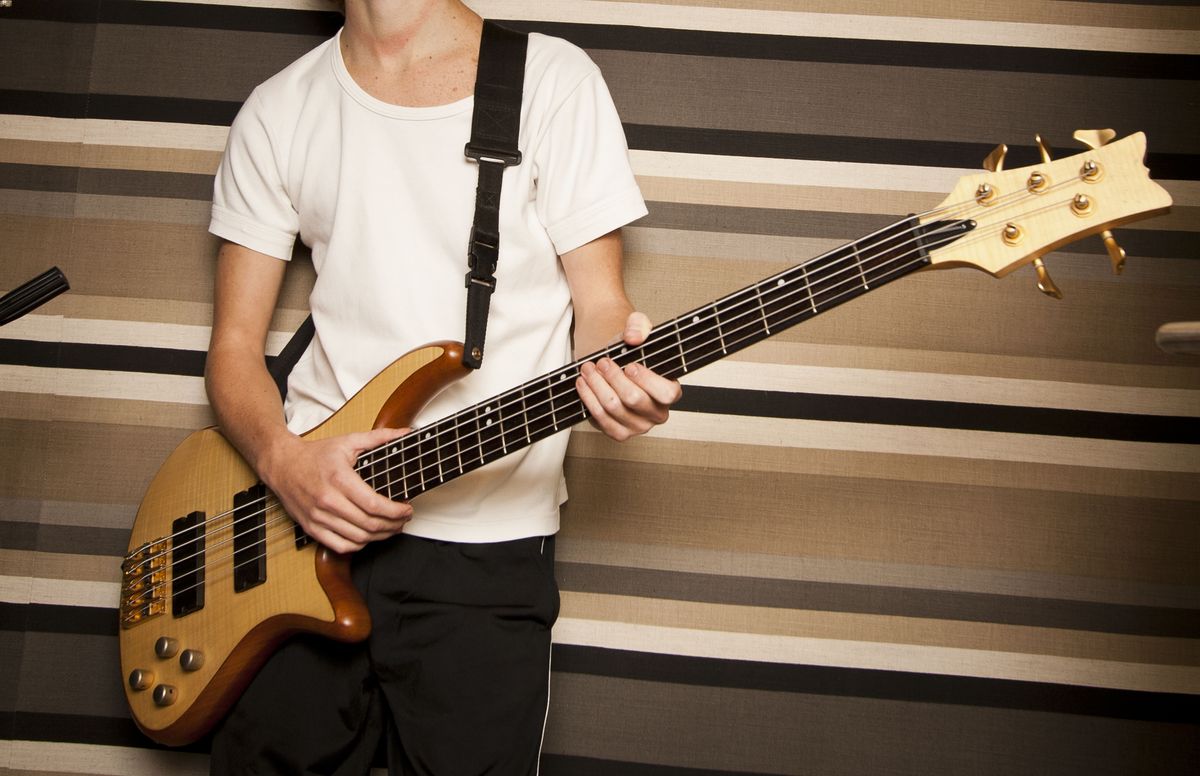Home>Instruments>Bass>How To Play Washtub Bass


Bass
How To Play Washtub Bass
Modified: January 22, 2024
Learn how to play the washtub bass and master the art of producing deep, resonant bass tones. Discover bass-playing techniques and get started on your musical journey today!
(Many of the links in this article redirect to a specific reviewed product. Your purchase of these products through affiliate links helps to generate commission for AudioLover.com, at no extra cost. Learn more)
Table of Contents
- Introduction
- Materials Needed
- Step 1: Choosing the Right Washtub
- Step 2: Selecting the Right String
- Step 3: Attaching the String to the Washtub
- Step 4: Creating the Neck
- Step 5: Tuning the Washtub Bass
- Step 6: Learning Basic Technique
- Step 7: Playing Different Notes
- Step 8: Adding Rhythm and Groove
- Step 9: Tips for Maintenance and Care
- Conclusion
Introduction
Have you ever heard the deep, resonant tones of a washtub bass? This unique instrument, also known as a gutbucket or a broomstick bass, is an essential component of traditional American folk and blues music. Its simple design and rich, booming sound make it a favorite among musicians seeking to add a touch of authentic bass to their music.
In this article, we will guide you through the process of playing the washtub bass, from choosing the right materials to mastering the basic techniques. Whether you’re a seasoned musician or a beginner, this article will provide you with all the information you need to start playing this eccentric and charming instrument.
Before we get started, it’s important to note that playing the washtub bass requires a certain level of creativity and improvisation. It’s an instrument that invites experimentation and allows you to create your own unique sound. So, let’s dive in and discover the joy of playing the washtub bass!
Materials Needed
Before you embark on your washtub bass journey, it’s essential to gather the necessary materials. Don’t worry; you won’t need a lot of fancy equipment. Here’s a list of what you’ll need:
- Washtub: The most critical component of a washtub bass is, of course, the washtub itself. You can find suitable options at your local hardware store or even repurpose an old washtub. Look for a sturdy, metal tub with a deep and resonant sound.
- String: Next, you’ll need a durable string to create the tension and produce the bass notes. Traditionally, a thick nylon string or a section of weed trimmer line works well. Experiment with different materials to find the sound you prefer.
- Stick or Neck: The neck of the washtub bass can be made from a variety of materials. A broomstick or a section of PVC pipe is commonly used. This component provides stability and allows you to adjust the tension of the string.
- Tuning Peg: To tune the washtub bass accurately, you’ll need a tuning peg. This can be a simple wooden dowel or a small piece of metal. It should be attached to the neck, allowing you to adjust the tension of the string easily.
- Bridge: The bridge is a small piece that supports the string and helps transmit the vibrations to the washtub. It can be made of wood, metal, or even a small block of Styrofoam, providing a solid base for the string.
While these are the essential materials needed for a basic washtub bass, feel free to experiment and customize your instrument. You might want to add extra decorations or personalize it to reflect your own style and personality.
Now that you have all the necessary materials, it’s time to move on to the next step: choosing the right washtub.
Step 1: Choosing the Right Washtub
The first step in building your washtub bass is selecting the right washtub. The washtub serves as the resonating chamber, so it’s crucial to choose one that will produce a deep and rich sound. Here are a few factors to consider:
- Size: Look for a washtub that is medium to large in size. A smaller tub may not have enough internal volume to produce a strong bass sound, while a larger tub may be challenging to handle and transport.
- Material: Ideally, the washtub should be made of metal, such as galvanized steel or aluminum. These materials provide a sturdy structure and excellent resonance. Avoid plastic tubs, as they tend to dampen the sound.
- Shape: The shape of the washtub can also affect the sound. A round or oval-shaped tub is often preferred, as it allows for better resonance. However, you can experiment with different shapes to find the one that suits your preference.
- Thickness: Consider the thickness of the metal. Thicker tubs will generally produce a deeper and more resonant sound. However, keep in mind that thicker metal also means increased weight.
- Sound Test: Before making a final decision, give the tub a tap or a thump and listen to the sound it produces. It should have a deep, booming quality with good sustain. If possible, try different washtubs to compare their sound and choose the one that resonates with you.
Remember, the right washtub will be the foundation of your instrument, so take your time to select the perfect one. Once you have chosen your washtub, you’re ready for the next step: selecting the right string.
Step 2: Selecting the Right String
Choosing the right string is crucial when it comes to creating the desired sound for your washtub bass. The string will determine the tone, resonance, and playability of your instrument. Here’s what you need to consider:
- Thickness: The thickness of the string will directly affect the tone and playability of your washtub bass. Thicker strings tend to produce a deeper and more resonant sound, while thinner strings offer a brighter tone. Experiment with different thicknesses to find the perfect balance for your preferred sound.
- Material: Nylon strings are a popular choice for the washtub bass due to their durability and flexibility. They provide a warm and rounded tone. However, you can also try other materials like fishing line or weed trimmer line. Each material will produce a slightly different sound, so feel free to experiment and find the one that suits your musical style.
- Tension: The tension of the string is crucial for achieving the desired sound and playability. You want the string to be tight enough to produce a clear and resonant tone but not so tight that it becomes difficult to play. Adjust the tension accordingly and find the sweet spot that works best for you.
- Length: The length of the string will determine the pitch of the notes you can produce on your washtub bass. Longer strings generally produce lower-pitched notes, while shorter strings will result in higher-pitched tones. Experiment with different lengths to expand your tonal range and find the sound you prefer.
- Multiple Strings: Some musicians opt to use multiple strings on their washtub bass to create a fuller, more complex sound. If you choose to go this route, make sure the strings are evenly spaced and that they have similar tension to ensure a balanced sound.
Once you have selected the right string and have it ready to be attached to your washtub bass, you’re ready to move on to the next step: attaching the string to the washtub.
Step 3: Attaching the String to the Washtub
Now that you have chosen the right string for your washtub bass, it’s time to attach it to the instrument. This step is crucial for setting the proper tension and ensuring that the string will vibrate freely to produce a clear and resonant sound. Here’s how you can do it:
- Drill Holes: Start by drilling two small holes near the rim of the washtub, on opposite sides. Make sure the holes are slightly smaller than the diameter of your string.
- Thread the String: Insert one end of the string through one of the holes, from the outside to the inside of the washtub. Leave enough excess string to allow for adjustments and tying later.
- Secure the Bridge: Place the bridge (a small piece of wood, metal, or Styrofoam) on the inside of the washtub, positioned directly under the string. This will provide a stable surface for the string to rest on.
- Tie a Knot: Pull the string tight and tie a knot on the inside of the washtub to secure it in place. Make sure the knot is tight enough to prevent the string from slipping.
- Thread the String Through the Second Hole: Take the other end of the string and thread it through the second hole, from the inside to the outside of the washtub.
- Adjust the Tension: Pull the string tight and experiment with adjusting the tension. Play the string to test the sound and make further adjustments as needed until you achieve the desired pitch and tone.
Once you have successfully attached the string to the washtub, you’re ready to move on to the next step: creating the neck for your instrument.
Step 4: Creating the Neck
The neck of the washtub bass is an important component that provides stability, allows for string adjustments, and enables you to play the instrument comfortably. This step involves creating and attaching the neck to the washtub. Here’s what you need to do:
- Select the Neck Material: The neck can be made from various materials, such as a broomstick, a section of PVC pipe, or a sturdy wooden dowel. Choose a material that is comfortable to hold and fits your desired aesthetic.
- Measure and Cut the Neck: Measure the length you want for the neck and cut the material accordingly. Consider the scale length you prefer, which is the distance from the nut (or tuning peg) to where the string rests on the bridge.
- Attach the Neck to the Washtub: Position the neck on the washtub, aligned with the center of the hole where the string is attached. Use clamps or brackets to secure the neck firmly in place. Ensure that the neck sits at a slight angle, sloping downward from the washtub rim towards the bridge.
- Drill Holes for Tuning Pegs: Along the length of the neck, determine where you want to place the tuning pegs. Drill small holes at those locations, ensuring they align properly with the strings. These holes will hold the tuning pegs.
- Insert Tuning Pegs: Insert the tuning pegs into the holes you drilled, making sure they fit snugly. These pegs allow you to adjust the tension of the strings easily and fine-tune the pitch of each string.
Once the neck is securely attached to the washtub and the tuning pegs are in place, you are ready to move on to the next step: tuning the washtub bass.
Step 5: Tuning the Washtub Bass
Tuning your washtub bass is essential to ensure that each string produces the correct pitch and that your instrument sounds harmonious. Here’s how you can tune your washtub bass:
- Start with the Lowest String: Begin by tuning the lowest-pitched string first. This is usually the thickest string and will produce the deepest tones. Pluck the string and listen carefully to the pitch it produces.
- Loosen or Tighten the String: To adjust the pitch, turn the tuning peg for that string either clockwise or counterclockwise. Tightening the string will raise the pitch, while loosening it will lower the pitch. Make small adjustments and pluck the string again to check the pitch until it matches the desired note.
- The 12th Fret Rule: A helpful guideline for tuning the other strings is the “12th fret rule.” Press down the string at the 12th fret (the half point along the string’s length) and pluck it. The sound produced should be the same pitch as the open string below it. If it’s higher or lower, adjust the tension of the string using the tuning peg until both notes match.
- Repeat for Each String: Tune the remaining strings in the same manner as described above, moving from thickest to thinnest. Remember to use the 12th fret rule as a reference for each string to ensure accurate tuning.
- Check for Overall Harmonization: After tuning all the strings individually, play chords or simple melodies to check for harmonization. Listen for any strings that may be slightly out of tune and make further adjustments as needed.
It may take some time and practice to become accustomed to tuning your washtub bass accurately. Use a tuner or reference notes from another instrument if you need additional assistance while refining your tuning skills.
Once your washtub bass is in tune, you’re ready to move on to the next step: learning basic techniques to start playing the instrument.
Step 6: Learning Basic Technique
Now that you have your washtub bass tuned and ready to go, it’s time to learn the basic techniques of playing this unique instrument. Mastering these techniques will allow you to produce clear and consistent tones. Here are a few essential techniques to get you started:
- Plucking: Plucking is the most common technique used to produce sound on the washtub bass. Place your thumb or fingers on the string near the bridge and pluck or snap the string towards the center of the washtub. Experiment with different finger positions and pressures to find the sweet spot that produces the desired tone.
- Palm Muting: Palm muting involves lightly resting the palm of your hand on the string near the bridge while plucking. This technique dampens the sound and creates a shorter, muffled tone. Use it to add variation and dynamics to your playing.
- Slapping: Slapping involves striking the string with your thumb or the side of your hand to create a percussive, popping sound. Place your hand parallel to the string and quickly strike down on it, allowing the string to bounce off the fretboard. Experiment with different slapping techniques to produce unique rhythms and accents.
- Thumb Basslines: Use your thumb to play melodic basslines by plucking the string in a rhythmic pattern. Practice alternating between different notes and strings to create catchy basslines that complement the music you are playing.
- Harmonics: Explore the world of harmonics by gently touching the string at specific points while plucking it. This technique produces a bell-like overtone, creating a more ethereal and shimmering sound. Experiment with different fret positions to discover the harmonics that resonate with you.
Practice each technique slowly and focus on developing precision and control. As you become more comfortable, gradually increase your speed and experiment with incorporating different techniques into your playing. Remember, playing the washtub bass is a journey of self-expression, so don’t be afraid to explore and develop your own unique style.
Now that you have a solid foundation in basic technique, let’s move on to the next step: playing different notes on your washtub bass.
Step 7: Playing Different Notes
One of the exciting aspects of playing the washtub bass is the ability to produce different notes. By varying the positions of your fingers on the string and adjusting the tension, you can create a wide range of musical notes. Here’s how to play different notes on your washtub bass:
- Open String: Playing the open string means plucking or striking the string without pressing it down on any fret. This typically produces the lowest note on your instrument.
- Fretting: Similar to fretting on a guitar or bass, you can use your fingers to press down on the string against the fretboard. Experiment with different finger positions along the neck to produce different notes. The closer you move towards the bridge, the higher the pitch.
- Half Steps and Whole Steps: Each fret represents a half step or one semitone. Moving from one fret to the next on the same string will result in a half-step increase in pitch. Similarly, skipping one fret and moving to the next will produce a whole step or two semitone increase in pitch.
- Playing Scales: Scales are a series of notes played in a specific pattern. Start by practicing simple scales, such as the major scale or the pentatonic scale. These scales will help you familiarize yourself with the finger positions and intervals between notes on your instrument.
- Chords and Arpeggios: Explore playing chords and arpeggios on your washtub bass. Chords are multiple notes played together, while arpeggios are notes of a chord played individually. Experiment with different chord shapes and arpeggio patterns to create harmonic progressions and add depth to your playing.
As you practice playing different notes on your instrument, take your time to listen and train your ears to recognize the desired pitches. Focus on accuracy and precision, gradually expanding your repertoire of notes and patterns. With time and practice, you’ll develop the ability to play melodies, basslines, and even improvised solos on your washtub bass.
Now that you have learned how to play different notes, let’s move on to the next step: adding rhythm and groove to your playing.
Step 8: Adding Rhythm and Groove
Now that you can play different notes on your washtub bass, it’s time to focus on adding rhythm and groove to your playing. The rhythmic aspect is what gives your music its pulse and makes it enjoyable to listen and play along with. Here are some techniques to enhance your rhythm and groove:
- Learn Basic Rhythms: Start by mastering basic rhythms, such as quarter notes, eighth notes, and sixteenth notes. Practicing these rhythms with consistent timing will help you develop a solid foundation.
- Experiment with Strumming Patterns: Explore strumming patterns by using your thumb or fingers to strike the string in various rhythmic patterns. You can create an alternating bass pattern, emphasize beats with accents, or incorporate syncopation for a more complex rhythm.
- Embrace Syncopation: Syncopation involves emphasizing off-beat rhythms, adding unexpected accents, and creating rhythmic tension and release. Experiment with syncopated patterns to add flair and excitement to your playing.
- Play Along with a Metronome or Backing Track: Practicing with a metronome or playing along with a backing track can improve your sense of timing and help you develop a strong sense of rhythm. It also allows you to experiment with different tempo settings and musical styles.
- Explore Different Genres: Expand your horizons and explore different musical genres. Each genre has its distinctive rhythmic patterns and groove. Try playing blues, jazz, funk, or folk music to gain exposure to various rhythmic styles and infuse them into your own playing.
- Collaborate with Other Musicians: Playing with other musicians is a great way to enhance your rhythm and groove. It allows you to lock in with a drummer or other rhythm instruments, helping you develop a tighter sense of timing and improvisation. Jamming with others also encourages creativity and exploration.
Remember, rhythm and groove are an integral part of playing the washtub bass. Practice regularly, focus on timing, and listen to the rhythmic nuances in the music you love. As you gain confidence and experience, you’ll develop your unique style and feel for the instrument.
Now that you’ve learned how to add rhythm and groove, let’s move on to the final step: tips for maintenance and care to keep your washtub bass in excellent condition.
Step 9: Tips for Maintenance and Care
Maintaining and caring for your washtub bass is essential to keep it in excellent condition and ensure its longevity. Here are some tips to help you maintain and care for your instrument:
- Clean the Washtub: Regularly clean the washtub using mild soap and water. This will help remove dirt, grime, and any residue that may accumulate over time. Dry the washtub thoroughly after cleaning to prevent rusting.
- Protect the Washtub: When not in use, store your washtub bass in a safe and dry environment. Consider covering it with a cloth or case to protect it from dust, humidity, and potential damage.
- Check and Adjust the String: Periodically check the tension of the string and make any necessary adjustments. Over time, the string may loosen or stretch, affecting the instrument’s playability. Keep an eye out for any signs of wear or fraying and replace the string if necessary.
- Keep the Neck Stable: Ensure that the neck remains securely attached to the washtub. Check the clamps or brackets regularly and tighten them if needed. A loose neck can affect the instrument’s tone and playability.
- Protect the Finish: If your washtub bass has any decorative finishes, such as paint or varnish, be mindful of protecting them from scratches or damage. Consider adding a clear protective coating to safeguard the finish.
- Store Properly: When transporting or storing your washtub bass, make sure to secure the neck and string to prevent any unnecessary strain or damage. Use cushioning material, such as bubble wrap or foam, to protect the instrument from potential impacts.
- Regularly Inspect and Maintain: Conduct routine inspections of your instrument to catch any potential issues early on. Check for loose fittings, cracks, or any signs of damage. Address any necessary repairs promptly to avoid further complications.
- Learn from Others: Connect with fellow washtub bass enthusiasts and seek advice from experienced players. They can provide valuable insights and tips based on their own maintenance and care routines.
- Enjoy and Explore: Above all, enjoy playing and exploring the possibilities of your washtub bass. Experiment with different techniques, styles, and genres. Embrace the unique character and charm of this extraordinary instrument.
By following these maintenance and care tips, you can ensure that your washtub bass remains in optimal condition and continues to bring joy and music for years to come.
Congratulations on completing all the steps! Now it’s time to let your creativity soar and make beautiful music with your washtub bass. Happy playing!
Note: The washtub bass is a DIY instrument and may vary in design and materials used. Adjust the maintenance tips accordingly based on the specific construction of your instrument.
Conclusion
Congratulations on completing your journey to learn how to play the washtub bass! You have gained knowledge about choosing the right materials, attaching the string, creating the neck, tuning the instrument, learning techniques, playing different notes, adding rhythm and groove, and maintaining your washtub bass. As you continue to practice and explore, you’ll develop your unique style and deepen your musicality.
The washtub bass is a remarkable instrument that brings joy and character to any music style. Its deep, resonant tones make it a beloved choice for folk, blues, and other genres. With its simple design and unique sound, you’ll find endless possibilities for creativity and expression.
As you continue your musical journey with the washtub bass, remember to listen and learn from the great players who came before you. Seek inspiration from various styles and experiment with your own arrangements. By collaborating with other musicians and sharing your love for the instrument, you’ll create a vibrant community and continue to push the boundaries of what the washtub bass can do.
Now, it’s time to take what you’ve learned and let your imagination run wild. Embrace the joy of playing the washtub bass, tap into your creativity, and have fun making music with this unique and fascinating instrument. Whether you’re jamming with friends, performing on stage, or simply playing for your own enjoyment, the washtub bass is sure to bring smiles and captivate listeners.
So, go out there, play with passion, and let the deep, resonant notes of the washtub bass resonate through the air. Keep exploring, keep evolving, and keep the spirit of the bass alive!











